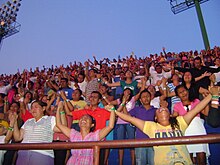From Wikipedia, the free encyclopedia

| International Pentecostal Holiness Church | |
|---|---|
| Classification | Protestant |
| Orientation | Pentecostal |
| Polity | Connectionalism[1] |
| Leader | Dr. A. Doug Beacham, Jr. |
| Associations | National Association of Evangelicals, Pentecostal/Charismatic Churches of North America, Pentecostal World Conference, Christian Churches Together, World Pentecostal Holiness Fellowship |
| Region | Worldwide: divided into 28 regional conferences |
| Founder | Abner Blackmon Crumpler, Benjamin H. Irwin |
| Origin | 30 January 1911 Falcon, North Carolina |
| Merger of | Fire-Baptized Holiness Churchand Pentecostal Holiness Church (1911), Tabernacle Pentecostal Church (1915) |
| Separations | Pentecostal Fire-Baptized Holiness Church (1918), Congregational Holiness Church(1920) |
| Congregations | 16,609 |
| Members | 4,600,000 |
| Official website | www.iphc.org |
| Statistics for 2012[2] | |
| Part of a series on |
| Pentecostalism |
|---|
 |
| Background |
| Early history |
| Key beliefs |
| Related movements |
The International Pentecostal Holiness Church (IPHC) or simply Pentecostal Holiness Church (PHC) is aPentecostal Christian denomination founded in 1911 with the merger of two older denominations. Historically centered in the Southeastern United States,[3] particularly the Carolinas and Georgia, the Pentecostal Holiness Church now has an international presence. In 2000, the church reported a worldwide membership of over one million—over three million including affiliates.[4]
Heavily influenced by two major American revival movements—the holiness movement of the late 19th century and the Pentecostal revival of the early 20th century[5]—the church's theological roots derive from John Wesley's teachings onsanctification.[6][7]
Several ministers who were raised in the Pentecostal Holiness Church have come to have greater name recognition than the church itself, such as Oral Roberts, an internationally known charismatic evangelist; Charles Stanley, a former
